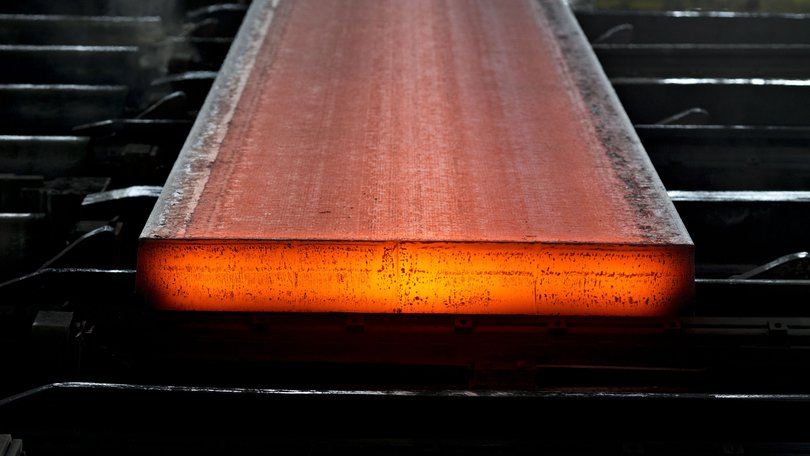THE NEW YORK TIMES: The world has too much steel, but no one wants to stop making it

At Tata Steel’s plant in IJmuiden on the outskirts of Amsterdam, cauldrons of lavalike molten steel are poured into long, thin trays that harden into identical 12-by-1-metre slabs of steel.
The end products, though, are strictly haute couture. Every item is made to order: battery casings that do not leak, crumple-zone car parts that absorb the force of a crash, cans that safely preserve food for years.
Very few companies in the world can produce this kind of advanced high-grade steel. Even so, Tata is being hit by the same forces that are pummeling every steelmaker: Manufacturers are producing more steel than the world can possibly use.
Sign up to The Nightly's newsletters.
Get the first look at the digital newspaper, curated daily stories and breaking headlines delivered to your inbox.
By continuing you agree to our Terms and Privacy Policy.Excess steel production is estimated to reach 721 million tons by 2027, according to the Organization for Economic Cooperation and Development.
One answer would be to simply make less steel. The problem is that no country wants to be the one to stop producing a material that is considered essential to its economic and national security.
Steelmaking has always held an outsize position as a symbol of economic power and prestige. It constitutes the fabric of modern life, used not only for buildings, roads, cars, refrigerators, electronics, forks and screws but also for weaponry, tanks and fighter jets.
In Europe, the recognition that the United States can no longer be relied on as the primary guarantor of its security has further underscored steel’s critical role in defense.
“Steel is fundamental to Britain’s industrial strength, to our security and to our identity as a primary global power,” Britain’s business and trade secretary, Jonathan Reynolds, told Parliament in April when the government passed emergency legislation to take control of the country’s last two operational blast furnaces.
No country can manufacture everything by itself, said Elisabeth Braw, a senior fellow at the Atlantic Council, a think tank. But when you list the products that you want guaranteed access to at any moment, “steel is one of them,” she added.
Over the past decade, a flood of cheap steel from China has transformed the global market. The country’s mammoth collection of mills — built in part with government support and often lacking the environmental controls mandated in Europe — make more steel, as well as aluminum, than the rest of the world combined. As China’s economy has slowed, more of these metals have been exported at cutthroat prices.
The result is sinking prices, shrinking profits and unemployed workers. Measured by the kilogram, steel costs less than bottled water. Smaller revenues also mean less money to invest in new low-carbon technologies, which are essential to meeting the European Union’s climate goals, the Organisation for Economic Cooperation and Development warned in May.
That has put governments in a tough spot. They want to protect jobs and an industry considered crucial to national security but also keep costs down and avoid having to pay out subsidies. They want to speed the transition to cleaner energy but also keep steelmaking competitive.
“This is one of the really problematic remnants of the heydays of globalization,” said Braw. People didn’t expect that the market “could be distorted in this way, and especially not in a way that collides with national security interests, but that is where we are.”
This spring, Tata, an Indian conglomerate, laid off 1600 people at the IJmuiden plant. Last year, steel manufacturers across the 27 countries in the European Union announced a total of 18,000 job cuts and the closure of 9 million tons of production capacity.
And in the first six months of this year, Germany, the bloc’s biggest steel producer, saw steel output decline 11.6 per cent — more than 17 million tons — from the same period in 2024.
The European Union imposes trade penalties intended to stop China from dumping its cheap steel on its markets. But Chinese steel keeps coming, prompting countries that were not traditionally steel exporters, like South Korea and Japan, to join the hunt for buyers elsewhere.
“It’s a domino effect,” said Lucia Sali, head of communications at the European Steel Association.
And now, aside from high energy and labour costs, ageing technology and fierce competition from China, European steelmakers must also contend with punishing American tariffs. President Donald Trump imposed 50 per cent tariffs on nearly all steel and aluminium imports last month, twice the amount he announced in March, in a bid to protect and pump up American producers.
The Trump tariffs not only threaten to significantly reduce the amount of steel Europe can sell in the United States. They also mean other steel producers around the world will be looking to redirect more and more of their exports to Europe, further increasing competition with companies at home.
Britain is in a better position than most. Trump exempted British steel from the additional 25 per cent tariff on steel and aluminium and has agreed to remove the remaining 25 per cent tariff in the future.
Still, Britain’s ageing plants are having trouble surviving.
This spring, the government took over the British Steel complex in Scunthorpe, an industrial town in northern England. Jingye, the Chinese company that owned the plant, had threatened to shut it down, citing losses of 700,000 pounds a day (about $143,6155). Its two blast furnaces are the last in the country to produce steel from scratch using iron ore and coal, rather than from scrap metal.
Last year, the government also helped bail out Tata Steel, which runs a large mill at Port Talbot in Wales, with a 500 million pound grant to transition to a greener electric arc furnace that melts recycled steel.
In the Netherlands, Tata Steel’s plant in IJmuiden is in better shape. The site, which is the size of 1,100 soccer fields and sits next to a public beach, is one of the country’s largest industrial employers. The plant is the second largest in Europe.
The landscape includes towering smokestacks and miniature mountain ranges made from heaps of iron ore and coal. Tata Steel plans to convert the coal-powered plant to renewable hydrogen by 2030 and is negotiating with the Dutch government for subsidies.
And the company continues to invest in the next generation of workers, admitting 150 to 200 people to its training academy each year.
But the IJmuiden plant still has headaches. Dutch regulators have been fighting Tata Steel in court over fines and a potential closure of a coke oven because of its toxic emissions. The planned transition to lower-emissions technology will cost billions and take time.
At the moment, steel made with green hydrogen in electric arc furnaces and other greener production methods spew far less emissions but cost 30 per cent to 60 per cent more than conventional production, according to various estimates.
And then there are the tariffs. Tata said in a statement that 12 per cent of its sales were “US related” and that it passed on most of the 25 per cent tariff that went into effect in March to its American customers, which include Ford Motor, Chrysler, Caterpillar and Duracell.
But, the company added, it worries that with 50 per cent tariffs “our steel may become too expensive.”
This article originally appeared in The New York Times.
© 2025 The New York Times Company
Originally published on The New York Times
